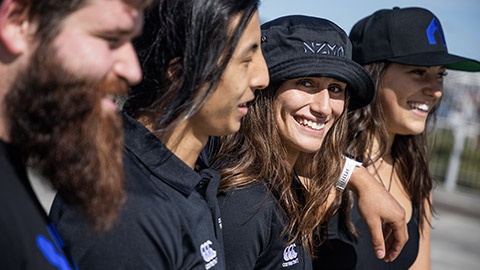Online tutoring is different from face-to-face tutoring. Learning Support provided by our Team Leaders, supported by the wider group of Learning and Development Leads and Learner Success Leaders, is there to support you in creating an asynchronous but engaging and connected environment. They are not your only support. The other tutors within the Online Campus are also a wealth of knowledge, as well as your Campus Manager. Working together on a solution to the challenge that is before you can be found.
Learning Support cannot offer specialised subject matter or content support – that will always fall to the tutor.
Learning Support can also be the conduit to other support systems for the student. It could be coordinating with the counselling service, if required, or the tutor/Team Leader for re-engagement/withdrawal.
To achieve the best for the student, communicate regularly and keep an open dialogue on who will do what and when.

There are a number of reasons why a student might have a barrier to learning. It could be a physical challenge, a mental challenge, a learning style challenge, an emotional challenge or even a motivational challenge. It could be a non-native English challenge, a numeracy/literacy challenge, a cultural challenge, or changes in their home environments. It’s important to listen and ask questions to understand what the challenge is, what has been done previously and what could be done differently in the future.
Learning differences vs learning disabilities (vs learning challenges)
The terminology might not be important to you, or it may be. It might not be important to the student, but it may. However, the words convey a different meaning so it might change your approach.
Learning disabilities imply the inability to learn, i.e. not able, but a dyslexic student can still learn; it’s just they learn differently from a non-dyslexic student. However, the Government use this term and ask institutes to implement their own Strategic Disability Action plan.
A learning difference may just be their level of numeracy or that they are red/green colour blind, which for a design task might be a minor obstacle. The written text may cause a challenge to a blind student, but using the READ/SPEAK accessibility tool will result in the written text becoming a spoken text. In all cases, it is about the student’s ability to learn, the hindrances that arise that create barriers to learning and how we, as educators, can support every student in achieving their absolute best.
This section is called Learning Barriers – what does that imply to you? A barrier has the meaning of stopping or impeding something. NZMA, and you obviously don’t want to create barriers for students. Reflection point: What creates those barriers? Do you have the power to remove the barriers?
Self-declared vs self-diagnosed vs undeclared
Students will declare their learning differences if they are confident and open. If they have an educational background where they were supported and celebrated for their uniqueness, then they will happily say “I have xxx.” or "I am xxx.". Students may feel embarrassed by their learning differences and either don’t tell people or don’t seek a professional diagnosis. Some parents will not seek a diagnosis when their child is at school due to the cost or the perceived stigma associated with a “disability”. Sometimes tutors gain an inkling that something is “not quite right”, so if you get those flagged moments, make a note, follow up carefully and perhaps speak with Learning Support. Sometimes it’s the case that a student will say, “Oh yeah, I have been assessed with XXX, but I didn’t think it was important.”. This is truer in an online asynchronous environment.
It’s important when discussing learning differences that we know if the situation has been diagnosed professionally. Students will often have educational psychologist reports to support their tutors in understanding the diagnosis. A diagnosed learning difference will mean that NZMA is required to support the student achieve through supporting their difference according to your policies, i.e. a dyslexic student can have a reader/writer for any exams, or an autistic student may have only one or two partners for group work. Or even there might be government funding to support the student through their studies. Undiagnosed or self-diagnosed is as good as googling a remedy for the medical problem you are having – it is not reliable. This doesn’t mean that it should be ignored. It means it should be noted, and the student should be encouraged to get a professional diagnosis. Talk to Learning Support to see if they can sort this out.
Supporting (self-declared) students
Often students will have learnt their own strategies to use when they approach different tasks. They are usually experienced in their own learning to know what works and what doesn’t. However, sometimes, the diagnosis comes at a later stage, and you will hear people say, “Now it all makes sense.” So, go by their lead when working out how to support them. Ask students what ways they learned in high school or previous studies. Ask them what they like to do and, importantly not like to do when studying.
After hearing and working with students on their strategies, now is the time to offer variations on their strategies or new ones. The Ako toolkit is a great starting resource, as well as your Team Leaders and the Learning and Development Leads.
If the challenge is not a self-declared issue, i.e. motivational, language, or cultural, you will have your own ways of supporting students. Your Team Leader or Learning and Development Leads will also have ideas to include when offering support, as well as the Ako toolkit.
Ensure you make a note in SELMA if necessary, as this will form part of NZMA’s evidence in our review processes and links to KEQ 4 in our self-assessment.
To teach, a tutor has a skillset to utilise, where the skillset is based on knowledge, experience and pedagogical beliefs.
A good pedagogy definition is described by Dr Paora Stucki (2021) as:
“Pedagogy might therefore be defined as encompassing a variety of teaching and learning methods and other teacher behaviours and characteristics grounded in theories of student learning and influenced by internal and external socio-political contexts.” (p. 7).
This has the overarching definition of beliefs and skills a tutor holds, as well as the environment the teaching and learning are happening.
There could be a number of barriers to teaching, be it on-campus or online teaching.
- Lack of knowledge of content.
- Lack of knowledge of the teacher role and the student role.
- Lack of knowledge on the balance of student-centred and teacher-centred delivery and creating an environment where students are autonomous and have agency in their learning.
- Lack of knowledge on delivery methods — we often teach how we learn. If you learn in a different way from a student, then potentially, you are not providing the best opportunity for the student to understand.
- Lack of knowledge in learning styles and supporting students to find their style as well as support them use the strategies best suited to them.
- Lack of knowledge of student’s learning differences and how to provide strategies for the student to use.
- Lack of knowledge in student motivation and how to improve this.
- Lack of knowledge of the student’s cultural, language, and learning backgrounds to know better how to support them through their journey.
Identifying your challenges and your barriers is the first step to finding a solution.
Solutions
- Get qualified – NZCATT level 4 is the basic level
- Seek guidance from your peers and Team Leader – we also are connected to the Learner Success Team, so we are not alone.
- Seek guidance from the leadership team.
- Find, share and refer to online reliable and reputable resources (academic or not) - such as Faculty Focus, Academia.edu, Researchgate.net. Ako Aotearoa, any of the open-source NZ university resources for students as well as teaching staff, such as Teaching Development: University of Waikato.
- Reflect and Connect – reflect backwards on what happened, why it went well, why perhaps not so well, and connect forward to how you will adjust to do it better and why you will adjust it.
Resources
- Ako resources
- Signposts – A professional development resource for new Tertiary teachers
- Goalpost – A Professional Development Resource for New Tertiary Teachers in their First Year
- ePosts – Enhancing tertiary learning and teaching through technology
- Te Whare Tapa Wha – video
Reference
Stucki, P. (2012). A Māori Pedagogy: Weaving The Strands Together. Kairaranga, 13(1), 7–12.
© Copyright 2021 New Zealand Management Academies Ltd.
These topics have been prepared especially for the students of New Zealand Management Academies Ltd. All rights reserved. This publication constitutes intellectual property of New Zealand Management Academies Ltd. This module is copyright. No part may be reproduced, stored in a retrieval system, or transmitted, in any form or by any other means, electronic, mechanical, photocopying, recording or otherwise without permission. Inquiries should be made to Head Office.
© UP Education Australia Pty Ltd 2023
Except as permitted by the copyright law applicable to you, you may not reproduce or communicate any of the content on this website, including files downloadable from this website, without the permission of the copyright owner.
WARNING
This material has been reproduced and communicated to you by or on behalf of UP Education in accordance with section 113P of the Copyright Act 1968 ( the Act ).
The material in this communication may be subject to copyright under the Act. Any further reproduction or communication of this material by you may be the subject of copyright protection under the Act.
Do not remove this notice.
Activity software obtained under the MIT License
Copyright © 2016 Joubel AS
Permission is hereby granted, free of charge, to any person obtaining a copy of this software and associated documentation files (the "Software"), to deal in the Software without restriction, including without limitation the rights to use, copy, modify, merge, publish, distribute, sublicense, and/or sell copies of the Software, and to permit persons to whom the Software is furnished to do so, subject to the following conditions:
The above copyright notice and this permission notice shall be included in all copies or substantial portions of the Software.
The software is provided "as is", without warranty of any kind, express or implied, including but not limited to the warranties of merchantability, fitness for a particular purpose and non-infringement. In no event shall the authors or copyright holders be liable for any claim, damages or other liability, whether in an action of contract, tort or otherwise, arising from, out of or in connection with the software or the use or other dealings in the software.
